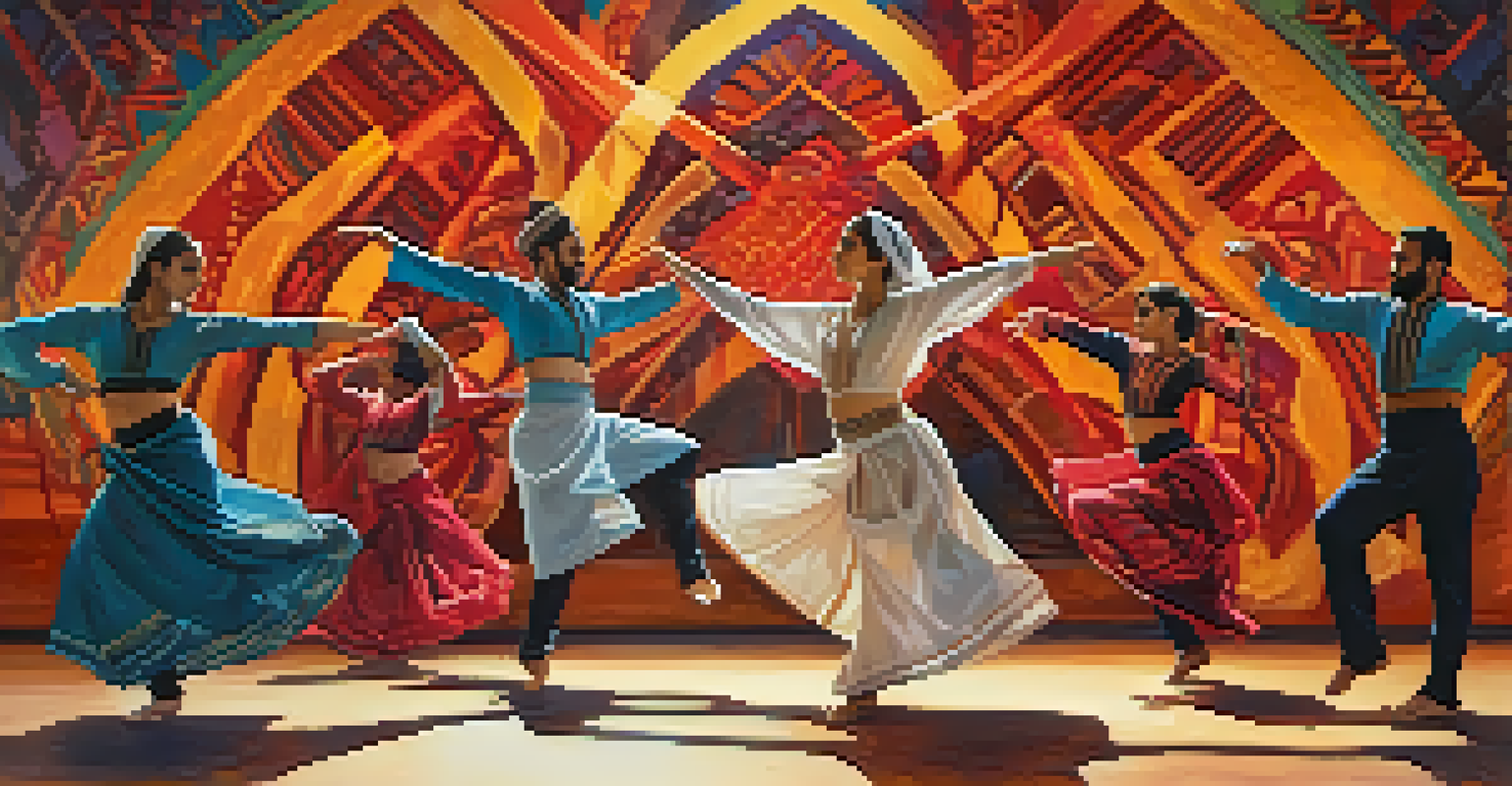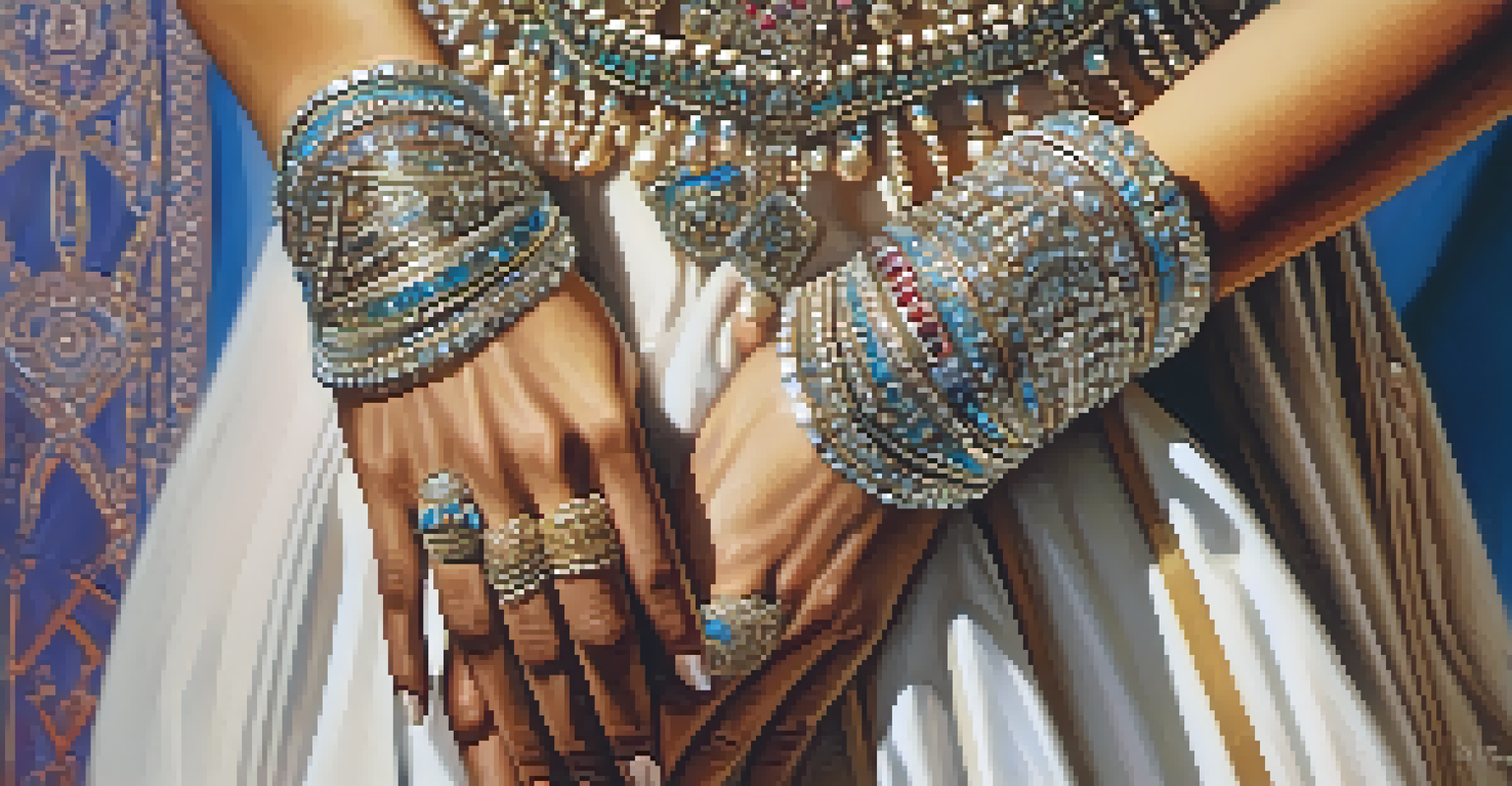How Middle Eastern Dance Styles Influence Global Performance Art

Middle Eastern Dance: A Rich Cultural Heritage
Middle Eastern dance, often referred to as belly dance, is not just a form of entertainment; it's a vibrant expression of culture and identity. The styles vary widely across the region, from the intricate movements of Egyptian raqs sharqi to the energetic folk dances of Turkey and Lebanon. Each of these dances tells a story, embodying the traditions, music, and emotions of its people.
Dance is the hidden language of the soul.
The roots of these dances can be traced back thousands of years, often linked to celebrations, fertility rites, and community gatherings. As these dances evolved, they absorbed influences from various cultures and historical events, creating a rich tapestry of movement that captures the essence of the Middle East. This historical depth adds layers of meaning that resonate with audiences worldwide.
Today, the revival of interest in Middle Eastern dance has led to workshops, performances, and festivals globally, allowing performers to connect with their heritage while sharing it with a broader audience. This exchange enriches the global performance art scene, offering fresh perspectives and creativity.
Fusion: Blending Dance Styles Across Cultures
One of the most exciting aspects of Middle Eastern dance is its ability to blend seamlessly with other dance forms, creating unique hybrid styles. Take, for instance, the fusion of belly dance with hip-hop or contemporary dance; these combinations bring a new energy and flair that attracts diverse audiences. This cross-pollination of styles not only showcases the versatility of Middle Eastern dance but also highlights the universal language of movement.

Performers often experiment with different genres, incorporating elements such as jazz or ballet into traditional Middle Eastern choreography. This fusion invites a broader range of interpretations and encourages dancers to explore their creativity. It's fascinating to see how a classic shimmy can transform when paired with a modern twist or beat.
Cultural Significance of Dance
Middle Eastern dance serves as a vibrant expression of culture, history, and identity, with each style reflecting its people's traditions and emotions.
Moreover, these innovative styles often lead to collaborations among artists from various backgrounds, fostering a spirit of inclusivity and shared artistic vision. This collaborative approach not only enriches the artists' experiences but also provides audiences with captivating performances that reflect the diversity of global culture.
Middle Eastern Dance in Popular Media
Middle Eastern dance has made significant inroads into popular media, influencing music videos, films, and stage performances. Iconic artists like Shakira and Jennifer Lopez have popularized belly dance moves, making them accessible to a global audience. These performances often spark interest in the cultural origins of the dance, encouraging viewers to learn more about its history.
The body says what words cannot.
In films, Middle Eastern dance often serves as a visual representation of exoticism and allure, capturing the audience's imagination. While this can sometimes lead to stereotypes, it also opens doors to greater appreciation and understanding of the culture. The challenge lies in presenting these dances authentically, avoiding cultural appropriation while celebrating their roots.
Television shows like 'So You Think You Can Dance' have also showcased Middle Eastern dance styles, introducing them to a younger generation. This exposure not only promotes appreciation for the art form but also inspires aspiring dancers to explore Middle Eastern techniques and incorporate them into their repertoire.
The Role of Social Media in Dance Evolution
Social media has transformed how Middle Eastern dance is shared and experienced, allowing dancers from around the world to connect and collaborate. Platforms like Instagram and TikTok serve as vital spaces for performers to showcase their skills, share tutorials, and spread their love for the art form. This online visibility has led to the emergence of new trends and styles, often influenced by global dance challenges.
With just a few clicks, a dancer in Cairo can inspire another in New York, leading to a dynamic exchange of techniques and ideas. Dancers have the opportunity to create content that resonates with a global audience, allowing traditional practices to evolve while staying true to their roots. This adaptability is crucial in keeping the art form relevant and engaging.
Fusion of Dance Styles
The blending of Middle Eastern dance with other genres, like hip-hop and contemporary, creates unique hybrid styles that attract diverse audiences and showcase artistic creativity.
Moreover, social media provides a platform for community building, where dancers can support and uplift each other. This sense of belonging fosters creativity and encourages performers to push boundaries, ultimately enriching the global tapestry of dance.
Educational Initiatives and Workshops
Educational initiatives and workshops play a crucial role in preserving and promoting Middle Eastern dance styles. Many dance academies and cultural organizations offer classes that introduce students to the rich history and techniques of various Middle Eastern dances. These sessions not only teach the physical aspects but also the cultural significance behind the movements.
By participating in workshops led by experienced dancers, students gain firsthand knowledge and appreciation for these art forms. This immersive experience fosters a deeper connection to the dance, encouraging participants to explore their own creativity and expression. It’s about more than just learning steps; it's about understanding the stories and traditions that accompany them.
Additionally, these workshops often attract diverse groups, allowing for cross-cultural exchanges that enhance the learning experience. As students from different backgrounds come together to learn, they create a vibrant community that celebrates the beauty of diversity in dance.
Influence on Contemporary Dance Companies
Contemporary dance companies have increasingly recognized the value of incorporating Middle Eastern dance styles into their work. By blending traditional movements with modern choreography, these companies create innovative performances that challenge conventional boundaries. This fusion results in a rich visual experience that captivates audiences and invites them to engage with the art form on multiple levels.
Choreographers often draw inspiration from the fluidity and expressiveness of Middle Eastern dance, infusing their pieces with its emotive qualities. This incorporation not only enhances the storytelling aspect of contemporary dance but also pays homage to the cultural origins of the movements. It's a beautiful way to highlight the interconnectedness of global dance traditions.
Social Media's Impact
Social media platforms facilitate global connections among dancers, allowing for the sharing of techniques and trends while fostering community and creativity within the art form.
As these contemporary pieces gain popularity, they also create opportunities for Middle Eastern dancers to showcase their talents on prestigious stages. This visibility can lead to greater recognition and appreciation for the dance styles, fostering a more inclusive environment within the performing arts.
The Future of Middle Eastern Dance in Global Performance
As the world becomes more interconnected, the future of Middle Eastern dance in global performance looks bright. With ongoing cross-cultural collaborations and the rise of digital platforms, these dance styles will continue to evolve and inspire. The blending of traditional and contemporary elements ensures that the art form remains dynamic and relevant in today’s cultural landscape.
Moreover, as more dancers from diverse backgrounds embrace Middle Eastern techniques, we can expect to see even more innovative interpretations emerge. This evolution will reflect the changing cultural narratives and highlight the importance of inclusivity in the performing arts. It's a testament to the power of dance as a universal language that transcends borders.

Ultimately, the influence of Middle Eastern dance on global performance art will continue to grow, fostering a deeper understanding and appreciation of this rich heritage. As audiences engage with these dances, they not only witness artistry but also connect with the stories and traditions that shape our world.